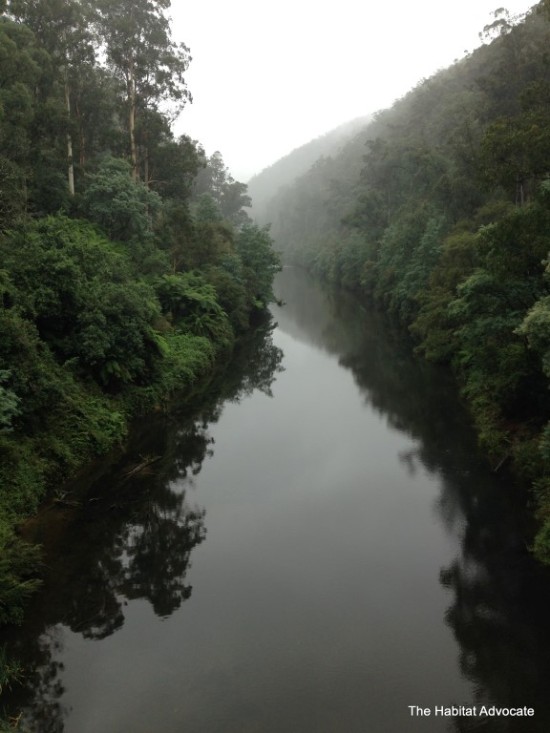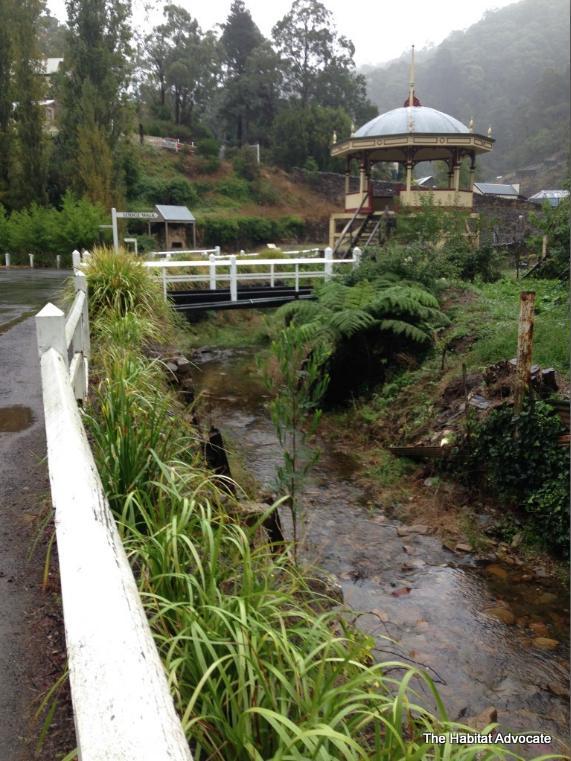Walhalla Mizzle
 Thomson River from Walhalla Road Bridge, Victoria, Australia.
Thomson River from Walhalla Road Bridge, Victoria, Australia.
(Photo by editor 20170322 looking north)
.
Walhalla Mizzle
.
It’s been raining gentle all night
In crisp mountain air
I sit on my dawn porch
I gaze through the grey mizzle
To the thick treed ridge
Covering the steep spur
.
Across Stringers Creek
The creek babbles far below
Feeding the mighty Thomson
Low heavy cloud envelops
Robins, larks, parrots, finches, firetails, martins or currawongs
Greet the daylight
.
Walhalla’s quiet now
As it should be up here
In the wild ranges steep
The 50 year army of gold reefers
Has long been and gone
Shafters taken their bargains and fortunes
Till the ground lay barren, the hills denuded, the Thomson damned
The batteries, the boilers and engines and waterwheel are gone
The miners, drinkers, shop keepers, the shafted
The school kids who played in bad soil
.
The long tunnels lie empty and dank
The dark shafts abandoned to victim ghosts
The slag heap lies as a mountainous waste
Still laced with arsenic
Stringers choked by discarded tailings
They all went back up over Little Joe, the twenty-five hundred
Back to their big smoke
.
The rail remains as industrious memory
To the heyday of industry and hardship
Fifteen tons of gold taken
On the marble column count
Dividends paid out
Two fires, a flood, disease and arsenic
Dozens perished for the gold fever
As the slain to Odin
.
The mizzle is pure till it touches the ground
Surrounding forest seems back
The creek tries flow as it did, crystal but dead
A heritage cancer cluster
A new breed of shafters.
.
 Stringers Creek, from Main Road, Walhalla
Stringers Creek, from Main Road, Walhalla
(Photo by editor 20170322)
.
Further Reading:
.
[1] “Elevated arsenic values can be detected up to 15 metres from the mineralised zone” – in ‘Nature of gold mineralisation in the Walhalla Goldfield, eastern Victoria, Australia‘, 2007, by Megan A. Hough, Laurent Ailleres (School of Geosciences, Monash University), Frank P. Bierlein (Centre for Exploration Targeting, University of Western Australia, Adele Seymon (Geoscience Victoria) and Stuart Hutchin (Goldstar Resources, Rawson),
^https://www.smedg.org.au/HoughOct07.html
.
[2] ‘Approaching a century-old legacy of arsenic and mercury contamination’, 2016, by Dr. Linda Campbell, Senior Research Fellow at Environmental Science, Saint Mary’s University, Halifax, Nova Scotia, Canada, ^http://ap.smu.ca/~lcampbel/Gold.html
.
[3] ‘Soil arsenic from mining waste poses long-term health threats’, 20120322 by Research Fellow at Melbourne School of Population Health, University of Melbourne, published in The Conversation, ^http://theconversation.com/soil-arsenic-from-mining-waste-poses-long-term-health-threats-5901
.
[4] ‘What are the effects of arsenic on human health?’, ^http://www.greenfacts.org/en/arsenic/l-2/arsenic-7.htm
.
[5] ‘Is there a cancer cluster in a CQ mining town?’ , 20141113, by Rachael Conaghan (Dysart in Central Queensland), ^https://www.dailymercury.com.au/news/is-there-a-cancer-cluster-in-a-cq-mining-town-conc/2452092/
.
[6] ‘Walhalla, Dec-Jan 2012-13‘, 20130303, ^https://daynaa2000.wordpress.com/2013/03/03/walhalla-dec-jan-2012-13/
.
[7] ‘Chronic arsenic poisoning‘, 2005, by Vanessa Ngan, Staff Writer, DermNet New Zealand – a world renowned resource all about the skin, ^http://www.dermnetnz.org/topics/chronic-arsenic-poisoning/
.
[8] ‘Thallium and Arsenic Poisoning in a Small Midwestern Town’, 2002, by Daniel E Rusyniak at Department of Emergency Medicine and Division of Medical Toxicology, Indiana University School of Medicine, Indianapolis, IN, USA, and R. Brent Furbee and Mark A Kirk, ^https://www.ncbi.nlm.nih.gov/labs/articles/11867986/
.
[9] ‘Cancer incidence and soil arsenic exposure in a historical gold mining area in Victoria, Australia: A geospatial analysis‘, 2012, by Dora Claire (University of Ballarat and Melbourne School of Population Health, The University of Melbourne), Kim Dowling (Melbourne School of Population Health, The University of Melbourne) and Malcolm Ross Sim (Monash University) in Journal of Exposure Science and Environmental Epidemiology (2012) 22, 248–257, ^http://www.nature.com/jes/journal/v22/n3/full/jes201215a.html
.
[10] ‘A cross-sectional survey on knowledge and perceptions of health risks associated with arsenic and mercury contamination from artisanal gold mining in Tanzania’, 20130125, by Elias Charles, Deborah SK Thomas, Deborah Dewey, Mark Davey, Sospatro E Ngallaba and Eveline Konje, at BMC Public Health, BioMed Central, London UK, ^https://bmcpublichealth.biomedcentral.com/articles/10.1186/1471-2458-13-74
.
[11] ‘Arsenic mine tailings and health’, 2015, Department of Health and Human Services, Victoria State Government, ^https://www.betterhealth.vic.gov.au/health/healthyliving/arsenic-mine-tailings-and-health
.
Tags: arsenic, Gold Mining, Little Joe, mining waste, polluted groundwater, Stringers Creek, Thomson River, Walhalla










It’s an excellent poem and its usage is a very effective way of introducing the topic of the toxic legacy of mining. Also, in view of the current Government’s policy on the Adani mine and mining in general, the poem is a very timely reminder that mining is not just about “Jobson Growth”, but more importantly the environmental destruction and toxic legacy that will stay with us for years, if not for ever, to deal with.
I would like to see this poem adopted by schools as part of the curriculum on the effects of mining on the natural environment and thereby on the wellbeing of the society.